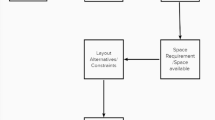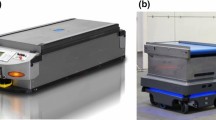Abstract
We conducted a simulation to compare the following two strategies for the allocation of improvement programmes in a flow shop environment with a single product type: (i) the allocation of improvement programmes focused on the capacity constraint resource and (ii) the allocation of improvement programmes distributed along the production line. Our results show that when the utilisation of the restrained resource is high and the difference in the processing time between the restrained resource and the non-constrained resource is significant (higher than 5 %), the allocation of improvement programmes focused on the capacity constraint resource is the best choice. Because utilisation of the restrained resource and the difference between the restrained resource and the non-constrained resource diminish, there are a growing number of cases in which the distributed strategy prevails. Based on our results, a third strategy is proposed, as follows: the allocation of improvement programmes distributed equally upstream from the restrained resource, including the restrained resource itself. Our results suggest that the third strategy is an interesting choice for situations in which focusing large improvements on the constrained resource is impracticable and the utilisation of this resource is high. Finally, we present an algorithm that enables production managers in a practical situation to make a proper choice among the three allocation strategies tested in this paper.
Similar content being viewed by others
References
Betterton CF, Cox JF (2008) Espoused drum-buffer-rope flow control in serial lines: a comparative study of simulation models. Int J Prod Econ 117:66–79
Blackstone JH Jr, Cox JF (2002) Designing unbalanced lines—understanding protective capacity and protective inventory. Prod Plan Control 13(4):416–423
Caridi M, Cigolini R, Farina V (2006) Designing unbalanced paced lines: a conceptual model and an experimental campaign. Prod Plan Control 17(5):464–479
Craighead CW, Patterson JW, Fredendall LD (2001) Protective capacity positioning: impact on manufacturing cell performance. Eur J Oper Res 134(v.2):425–438
Chakravorty SS, Atwater JB (2006) Bottleneck management: theory and practice. Prod Plan Control 17(5):441–447
Chelbi A, Rezg N (2006) Analysis of production/ inventory system with randomly failing production unit subjected to a minimum required availability level. Int J Prod Econ 99(1-2):131–143
Chica M, Cordón O, Damas S, Bautista J (2013) A robustness information and visualization model for time and space assembly line balancing under uncertain demand. Int J Prod Econ 143:761–772
Davis LE (1966) Pacing effects of manned assembly lines. Int J Prod Res 4(3):171
Ericksen PD, Stoflet NJ, Suri R (2007) Manufacturing Critical-path Time (MCT): the QRM metric for Lead time. Technical Report, Center for QRM, Wisconsin-Madison
Enns JT (2000) Evaluating shop floor input control using rapid modelling. Int J Prod Econ 229–241
Fenton NE (1999) A critique of software defect prediction models. IEEE Trans 25(5):675–689
Forrester JW (1961) Industrial dynamics. Productivity Press, Portland, p 464p
Gerchak Y (2000) On the allocation of uncertainty-reduction effort to minimize total variability. IEEE Trans, [SI] 32(5):403–407
Godinho Filho M, Uzsoy R (2011) The effect of shop floor continuous improvement programs on lot size—cycle time relationship for a multi- product single-machine environment. Int J Adv Manuf Technol 52(5-8):669–681
Godinho Filho M (2012) Effect of lot-size reduction and continuous improvement programs on work in process and utilization: a study for single-machine and flow-shop environments. Int J Logist Res Appl 15(5):285–302
Godinho Filho M, Uzsoy R (2012) The impact of simultaneous continuous improvement in set up time and repair time on manufacturing cycle times under uncertain conditions. Int J Prod Res 51(2):447–464
Godinho Filho M, Uzsoy R (2013) Assessing the impact of alternative continuous improvement programs in a flow shop. Int J Prod Res submitted, 2013
Goldratt E, Cox J (1984) The goal: excellence in manufacturing. North River Press, Croton-on-Hudson
Guimaraes AA, Godinho Filho M, Oprime P (2013) Guiding improvement programs towards lead-time reduction in a single-machine environment. Int J Adv Manuf Technol. doi:10.1007/s00170-012-4475-7
Hadjinicola GC, Soteriou AC (2003) Reducing the cost of defects in multistage production systems: a budget allocation perspective. Eur J Oper Res 145:621–634
Hillier FS, Boling RW (1966) The effect of some design factors on the efficiency of production lines with variable operations. J Ind Eng 17(12):651–658
Hillier FS, So KC (1996) On the robustness of the bowl phenomenon. Eur J Oper Res 89(3):496–515
Hong JD, Hayya JC (1995) Joint investment in quality improvement and setup reduction. Comput Oper Res 22:567–574
Hopp WJ, Spearman ML (2001) Factory physics: foundations of manufacturing management. Irwin, Nova Iorque, 698p
Hopp WJ, Spearman ML (2008) Factory physics: foundations of manufacturing management, 3ªth edn. McGraw Hill Higher Education, Nova York, 720p
Kadipasaoglu SN, Xiang W, Hurley SF, Khumawala BM (2000) A study on the effect of the extent and location of protective capacity in flow systems. Int J Prod Econ 63:217–228
Payne S, Slack N, Wild R (1972) A note on the operating characteristics of “balanced” and “unbalanced” production flow lines. Int J Prod Res 10(1):93–98
Petrick IJ, Echols AE (2004) Technology roadmapping in review: a tool for making sustainable nem product development decisions. Technol Forecast Soc Chang 71:81–100
Probert DR, Farrukh CJP, Phaal R (2003) Technology roadmapping—developing a practical approach for linking resources to strategic goals. Proc IMechE B J Eng Manuf 217:1183–1195
Rau H, Chu YH, Cho KH (2005) Layer modelling for the inspection allocation problem in re-entrant production systems. Int J Prod Res 43(17):3633–3655
Shingo S (1986) Zero quality control: source inspection and the Poka-yoke system. Productivity Press, Cambridge, p 303
Shingo S (2003) Sistema de troca rápida de ferramenta: uma revolução nos sistemas produtivos. Bookman, Porto Alegre, 327p
Slack N, Chambers S, Johnston R (2002) Administração da produção. Atlas, São Paulo
Smunt TL, Perkins WC (1985) Stochastic unpaced line design—review and further experimental results. J Oper Manag 5(3):351–373
Smunt TL, Perkins WC (1989) Stochastic unpaced line design—a reply. J Oper Manag 8(1):55–62
Suri R (2010) The power of time. Productivity, New York
Thawesaengskulthai N, Tannock JDT (2008) A decision aid for selecting improvement methodologies. Int J Prod Res 46(23):6721–6737
Thomson WW Jr, Burford RL (1988) Some observations on the bowl phenomenon. Int J Prod Res 26(8):1367–1373
Womack JP, Jones DT, Ross D (1990) The machine that changed the world. Harper Perennial, New York
Author information
Authors and Affiliations
Corresponding author
Appendices
Appendices
1.1 Appendix 1: Results for scenario 1
1.2 Appendix 2: Results for scenario 2
1.3 Appendix 3: Results for scenario 3
1.4 Appendix 4: Results for scenario 4
Rights and permissions
About this article
Cite this article
Godinho Filho, M., Utiyama, M.H.R. Comparing different strategies for the allocation of improvement programmes in a flow shop environment. Int J Adv Manuf Technol 77, 1365–1385 (2015). https://doi.org/10.1007/s00170-014-6553-5
Received:
Accepted:
Published:
Issue Date:
DOI: https://doi.org/10.1007/s00170-014-6553-5




